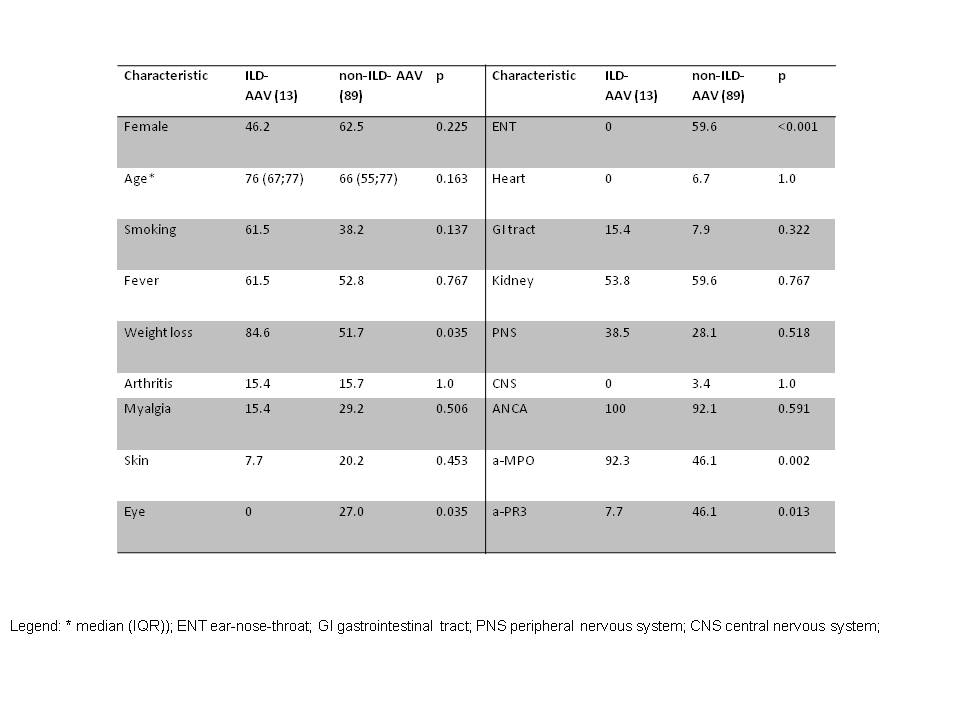Session Information
Session Type: Poster Session C
Session Time: 9:00AM-11:00AM
Background/Purpose: Recently, an association between anti-neutrophil cytoplasmic antibody (ANCA)-associated vasculitis (AAV) and interstitial lung disease (ILD) has been uncovered. We aimed to determine the rate of ILD in our AAV patient cohort and to compare clinical characteristics of AAV patients with and without associated ILD.
Methods: We analysed medical records of prospectively diagnosed and followed AAV patients at our secondary/tertiary rheumatology centre between January 2010 and May 2020. The diagnosis of ILD was based on lung HRCT findings.
Results: During the observation period, we identified 102 incipient AAV patients (50 had granulomatosis with polyangiitis, and 52 microscopic polyangiitis). Thirteen (12.7%) patients had ILD (ILD-AAV group). 12/13 had usual interstitial pneumonia (UIP) pattern and 1/13 non-specific fibrosis on HRCT. ILD was diagnosed in tandem with AAV in 9/13 patients, and 9 months to 5 years prior to AAV in 4/17 patients. Characteristics of ILD-AAV, and non-ILD-AAV groups are presented in Table 1. ILD-AAV patients more commonly reported of weight loss, less frequently had ENT involvement, and were predominantly a-MPO ANCA positive (92.3%). Follow up data were available for 90 AAV patients (88.2%; 13 ILD-AAV and 77 non-ILD-AAV). During the median (IQR) follow up of 30.6 (11.4; 62.8) months, 5/13 (38.5%) ILD-AAV patients died, compared to 7 (9.1%) deaths registered in non-ILD-AAV group. The crude mortality rate evaluated by Cox proportional hazards regression was significantly higher for AAV-ILD group (HR 5.5 (95%CI 1.7-17.3), p=0.004).
Conclusion: In our incipient AAV cohort 13% of patients presented with ILD. The AAV patients with ILD had a higher mortality rate than the rest of the cohort.
 Table 1. Clinical characteristics of ILD-AAV and non-ILD-AAV group
Table 1. Clinical characteristics of ILD-AAV and non-ILD-AAV group
To cite this abstract in AMA style:
Hocevar A, Perdan Pirkmajer K, Tomsic M, Rotar Z. Interstitial Lung Disease in Patients with ANCA Associated Vasculitis – a Prospective Single Centre Study [abstract]. Arthritis Rheumatol. 2020; 72 (suppl 10). https://acrabstracts.org/abstract/interstitial-lung-disease-in-patients-with-anca-associated-vasculitis-a-prospective-single-centre-study/. Accessed .« Back to ACR Convergence 2020
ACR Meeting Abstracts - https://acrabstracts.org/abstract/interstitial-lung-disease-in-patients-with-anca-associated-vasculitis-a-prospective-single-centre-study/
